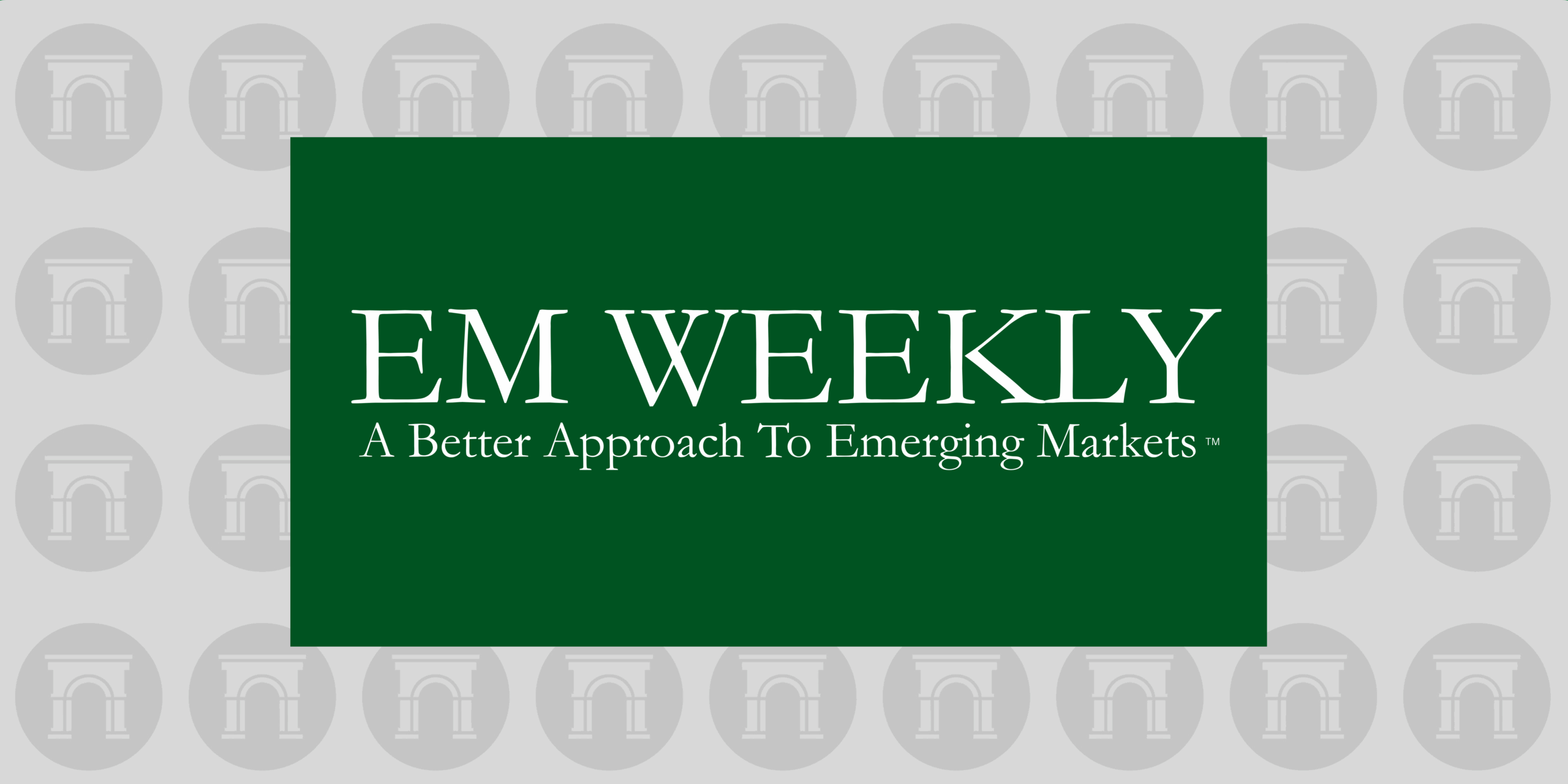Contents
Market Overview
Macro Update
The Israel-Iran attacks dominated headlines this week, continuing to escalate as the two sides exchanged heavy air strikes, while the U.S. considered entering the conflict. The Israeli Air Force claimed “complete control” of Iranian skies and issued evacuation orders for parts of Tehran, but it remains unclear if Israel could fully eliminate the Islamic Republic’s uranium enrichment capabilities without direct U.S. military support. President Donald Trump left the G7 summit in Canada abruptly under the pretext of the Middle East crisis and called for Iran’s “unconditional surrender” amid ongoing relocation of significant U.S. military assets to the region and troops put on high alert. Iran’s political leadership has remained defiant, with supreme leader Ali Khamenei rejecting President Trump’s demands and threatening “irreparable damage” if the U.S. joins Isreal in attacking Iran. Russian President Vladimir Putin, who is a key supporter of Iran’s regime but also maintains a strong relationship with Israeli Prime Minister Benjamin Netanyahu, has offered to intervene.
As the week came to a close, President Trump said he would decide “within two weeks” if the U.S. will join Israeli military action against Iran in order to “give diplomacy a chance.” Meanwhile, European foreign ministers met senior Iranian officials in Geneva to seek a diplomatic solution to the crisis.
As widely expected, amid “unusually elevated uncertainty” as emphasized by Federal Reserve Chair Jerome Powell, the FOMC left the fed-funds target range unchanged at 4.50% (upper bound) and kept its median projections of two rate cuts this year. The Fed revised its median inflation projection at year-end 2025 higher to 3.0% from 2.7%, while marking economic growth down to 1.4% from 1.7%, suggesting expectations of stagflation.
The Bank of England (BoE) held rates unchanged at 4.25% as expected, against the backdrop of a sharp increase in UK unemployment claims and weakening, but still relatively elevated, wage growth. Meanwhile, inflation came in at 3.4% year-over-year in May, down from 3.5% in April, but slightly above market expectations (3.3%) and remains well above BoE’s 2% target. May retail sales were significantly below expectations (-2.7% month-over-month vs. -0.5%) and decelerated sharply from a revised +1.3% in April.
The Bank of Japan (BoJ) kept its main policy rate at 0.50%, as widely expected. It appeared to lower the bar for a potential rate hike if the global trade war shock turns out to have less of an impact on Japan’s economy than feared and amid headline CPI remaining at 3.5% year-on-year in May.
Against renewed hopes of a diplomatic solution to the Middle East crisis, markets closed the week mixed. Oil gave back a bit of its recent gains, but Brent and WTI prices remain in the mid-$70s per barrel, from as low as $60 in early May. Equity markets staged a modest recovery, but still ended the week in the red, with the Dow Jones around 1.5% lower on the week. U.S. Treasury yields finished the week 2-3bps tighter and the USD gained marginally to around 99 on the DXY. EURUSD remained stable at 1.15. Gold trended lower this week, but remains close to its recent multi-year peak of around $3400 per oz.
In the meantime, May “hard data” for the U.S. economy came in weaker than expected across the board, reminding markets that the effects of unprecedented global economic uncertainty may only be starting to creep into macro data. Headline retail sales fell 0.9% month-over-month vs. -0.6% expected and a downwardly revised -0.1% in April, mainly driven by a pullback in spending on motor vehicles and parts (-3.5%) that surged in April amid President Trump’s Liberation Day announcement. Industrial production, capacity utilization, housing starts, and building permits all underperformed consensus expectations. Initial jobless claims came in flat, continuing to trend at around 250,000 weekly. Soft data published at the end of the week pointed to more weakness ahead: The Philadelphia Fed business outlook remained flat at -4.0 in June (vs. expectations of -1.5) and the May Leading Index fell 0.1%, following a downwardly revised April reading, to -1.4%.
In China, May retail sales surged significantly more than expected (+6.4% year-over-year vs. +4.9%), driven mainly by an early online shopping festival and government subsidies for home appliances, but amid still weak consumer sentiment the uptick might be short-lived. May industrial production reflected persistent weakness, decelerating to 5.8% year-over-year from 6.1% in April and below consensus expectations of 6.0%. The 1-year and 5-year loan prime rates were kept unchanged at 3.0% and 3.5%, respectively.
Beyond the systemic central banks, policymakers delivered rate decisions across a number of developed and emerging economies: The Swiss National Bank (SNB) delivered a 25bps cut to 0% in line with expectations and hinted at the possibility of a negative interest rate amid record CHF strength. Norway’s Central Bank surprised with a 25bps cut to 4.25%, citing “sufficiently tamed” inflation and signaled further cuts ahead. Next door in Sweden, the authorities also cut 25bps to 2.0%, as expected. The Philippines Central Bank cut by 25bps to 5.25%, also as expected. On the other side of the world and going in the opposite direction, Brazil’s Central Bank hiked the SELIC rate by 25bps to 15.00% and signaled that rates will remain high as long as needed to re-anchor medium-term inflation expectations. Pakistan (11.0%), Chile (5.0%), Indonesia (5.50%), Taiwan (2.0%) and Türkiye (46.0%) all held rates unchanged. These divergent monetary policy trends continue to be driven by regional and country idiosyncratic factors.
May CPI prints showed headline inflation slowing down in Israel, Saudi Arabia, Italy, Nigeria, and Poland, while in the eurozone and South Africa it was unchanged from April.
In the eurozone, the preliminary consumer confidence reading for June showed more deterioration than expected (-15.3 vs. -14.9 consensus and -15.1 in May). However, German investor expectations jumped sharply to 47.5 in June from 25.2 in May, comfortably outperforming consensus expectations of 35 as the forthcoming surge in public spending outweighed concerns about U.S. tariff uncertainty.
In geopolitics more broadly, President Trump floated the idea of Russia’s readmission to the G7, arguing that the ongoing conflict in Ukraine would not have occurred if Russia had not been expelled in 2014 following the annexation of Crimea. Meanwhile, Moscow has intensified its military actions in Ukraine, launching air strikes focused on Kyiv with hundreds of drones and rockets.
As expected, the White House has granted TikTok a third, 90-day extension to continue its operations in the United States, pending its Chinese owner divesture from the app.
EM Credit Update
EM hard currency sovereign debt posted a 0.2% gain for the week, evenly spread between the high-yield and investment-grade segments. At the index level, spreads were 1bp wider, with investment-grade widening by 2bps and high-yield by 1bp.
Africa led regional performance, with oil-dependent credits leading the gains amid the massive oil rally of the last few weeks. Argentina was the top underperformer this week amid some profit taking and Ukraine continued to trend lower amid intensifying Russian military pressure.
EM local currency sovereign debt lost 0.6% this week, amid marginally stronger USD, but year-to-date, this segment remains a standout, returning 10.2%.
EM corporate debt was in line with sovereigns this week, posting a 0.2% return at the index level. Investment-grade modestly outpaced high-yield (0.2% vs. 0.1%), with spreads 1bp and 6bps wider, respectively.
Primary market activity picked up this week compared to recent ones, with 19 corporate and two sovereign (Hungary and the Bahamas) deals pricing.
The Week Ahead
In the Hague, a NATO Summit will be held through June 25th and President Trump is expected. In Brussels, EU foreign ministers meet through June 27th and an EU-Canada summit with Prime Minister Mark Carney begins June 23rd. On the other side of the Atlantic, Fed Chair Powell will deliver the semiannual congressional testimony as House lawmakers return from recess and get back to work on President Trump’s “Big and Beautiful” bill.
In China, the Standing Committee of the National People’s Congress will meet in Beijing through June 27th and the World Economic Forum’s Annual Meeting of the New Champions, also referred to as the “Summer Davos” will be held in Tianjin. On the macro data front, PMI prints will be released by almost all major economies, including the U.S., eurozone and UK. May CPI prints are due in Singapore, Canada, Malaysia, Australia and central bank rate decisions in Hungary, Thailand, Mexico and Colombia. The eurozone will report economic and consumer confidence, while next week’s U.S. data include the Conference Board’s consumer confidence, goods trade, revised GDP, durable goods, initial jobless claims, personal income, PCE price index, and the University of Michigan consumer sentiment.
Fixed Income
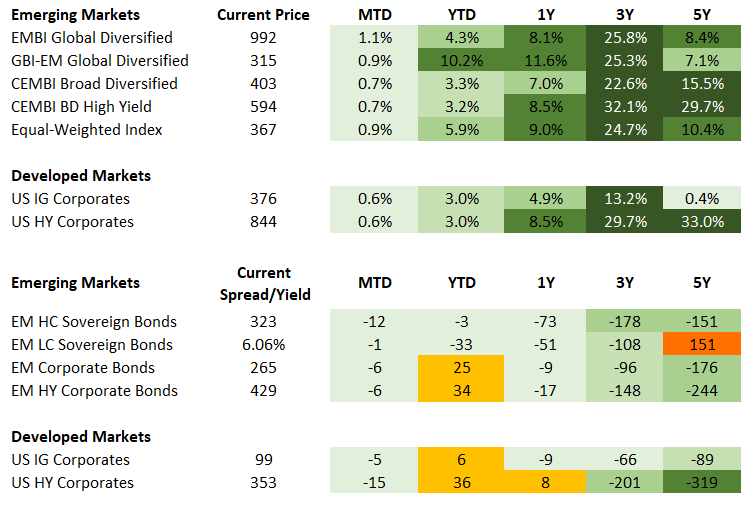
Equities
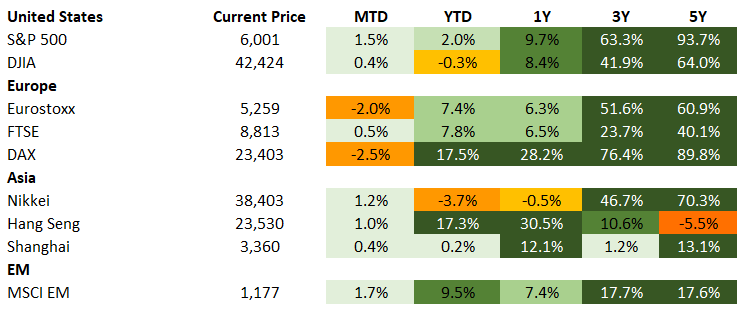
Commodities

Source for data tables: Bloomberg, JPMorgan, Gramercy. EM Fixed Income is represented by the following JPMorgan Indicies: EMBI Global, GBI-EM Global Diversified, CEMBI Broad Diversified and CEMBI Broad High Yield. DM Fixed Income is represented by the JPMorgan JULI Total Return Index and Domestic High Yield Index. Fixed Income, Equity and Commodity data is as of June 20, 2025 (mid-day).
Highlights
Romania Government Formation Process Underway
Event: The newly elected pro-EU centrist President Nicusor Dan appointed Ilie Bolojan of the center-right National Liberal Party (PNL) and interim President as Prime Minister. Bolojan now must formalize a coalition and receive approval from parliament before launching much-needed fiscal measures. Romanian bonds and foreign exchange strengthened on the news.
Gramercy Comment: Government formation is a key step in the process to address Romania’s strained fiscal accounts. The country’s deficit is currently expected to exceed 7.8% of GDP this year, according to the IMF’s April forecast, and remains above the European Commission’s 7.0% of GDP target. Markets should welcome a relatively swift coalition formation process whereby authorities can quickly turn to debate and pass additional fiscal consolidation measures to fend-off negative rating pressure and ease risks to EU funding.
Further, expenditure management related to wages and pensions as well as other spending cuts and revenue measures will be debated in the context of a still fragmented legislature and polarized population. All three rating agencies have the sovereign at the lowest investment grade rating with negative outlooks, with the next scheduled rating decision by Fitch on August 15th. While we expect near-term patience from the agencies as debt levels are still moderate, enhanced policy effectiveness under the new government that allows for better fiscal management is needed to avoid loss of the country’s investment-grade ratings.
Thai Government Coalition in Turmoil
Event: The second largest party in Thailand’s ruling coalition pulled out from the political alliance amid a disagreement with Prime Minister Paetongtarn Shinawatra over a key ministerial post, raising concerns about the government’s ability to remain in power. Meanwhile, a leaked recording of the PM’s conversation with a senior Cambodian politician has triggered sharp criticism domestically over management of the ongoing border tensions with Thailand’s neighbor, piling additional political pressure on Ms. Shinawatra.
Gramercy Comment: Even after the departure of its main coalition partner, Ms. Shinawatra’s coalition will retain a majority of around 260 in the 500-seat parliament. However, it will be very small and susceptible to further departures. This is likely to have negative implications for policy implementation, including the 2026 budget process that could now face delays. This latest political uncertainty in Thailand, a country with a history of social unrest and military coups, could evolve in various directions, including a potential government collapse and early elections, or even yet another military coup. The Thai economy has exhibited resilience to such political turmoil in the past and macro fundamentals have trended in a constructive direction lately amid improving current account and inflation dynamics. However, as an open economy, Thailand is exposed to regional and global dynamics that remain highly uncertain amid China-U.S. trade tensions and other top-down global risks. While we expect Thai economic resilience to persist in the near term, we’ll be vigilant for signs of material deterioration in the political environment that could weigh on market sentiment.
Emerging Markets Technicals
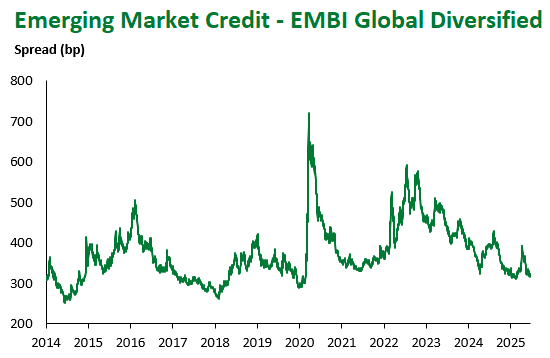


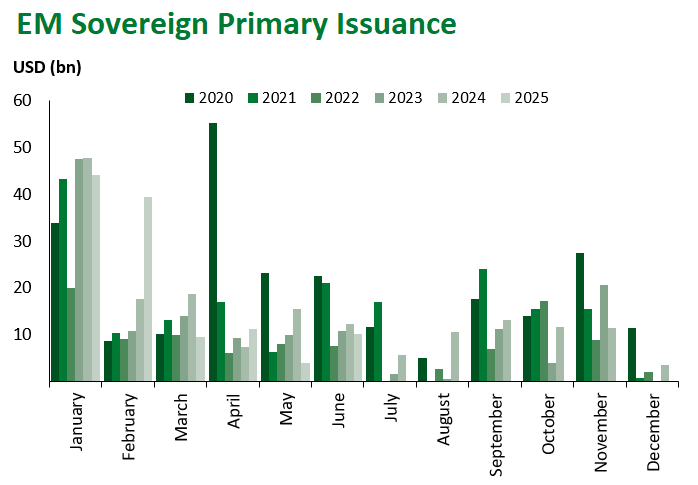
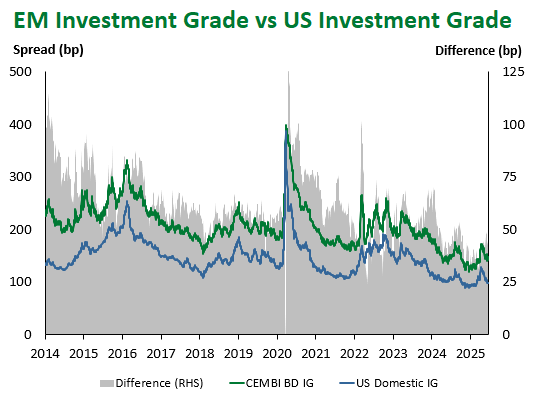
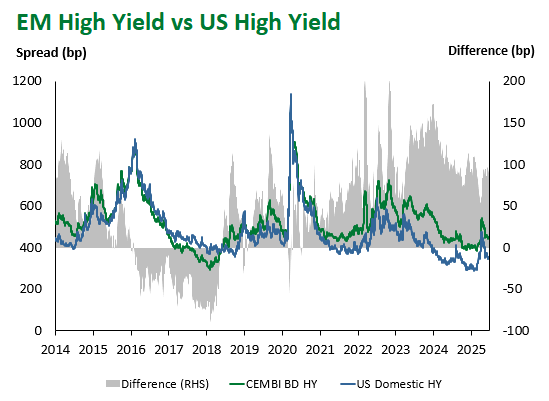
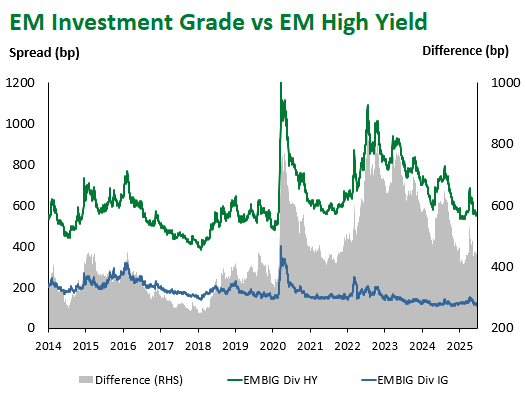
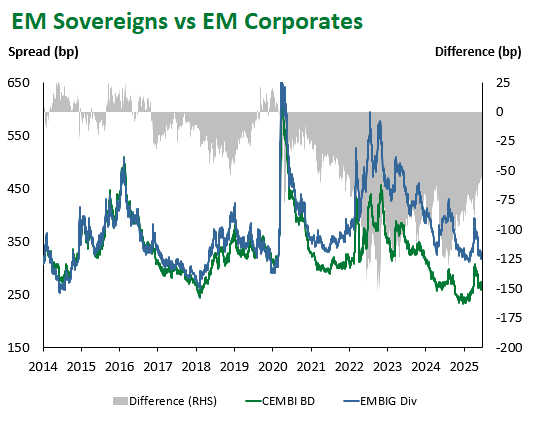
Emerging Markets Flows
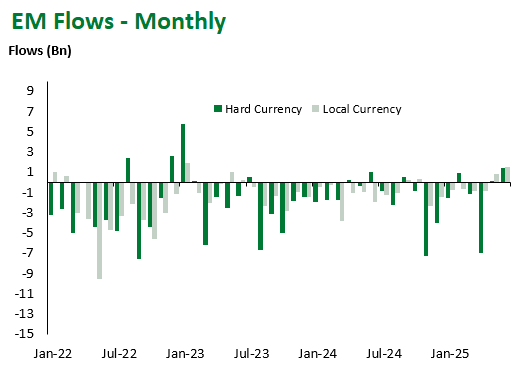
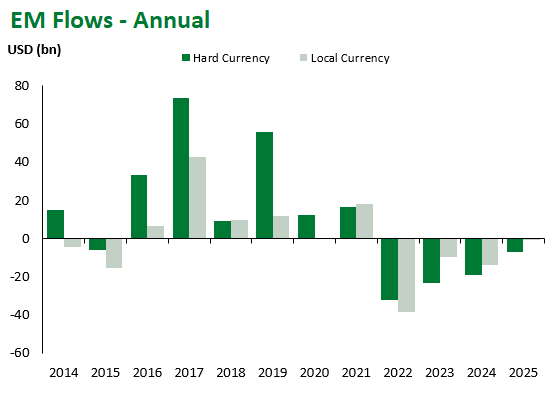
Source for graphs: Bloomberg, JPMorgan, Gramercy. As of June 20, 2025.
For questions, please contact:
Kathryn Exum, CFA ESG, Director, Co-Head of Sovereign Research, [email protected]
Petar Atanasov, Director, Co-Head of Sovereign Research, [email protected]
This document is for informational purposes only. The information presented is not intended to be relied upon as a forecast, research or investment advice, and is not a recommendation, offer or solicitation to buy or sell any securities or to adopt any investment strategy. Gramercy may have current investment positions in the securities or sovereigns mentioned above. The information and opinions contained in this paper are as of the date of initial publication, derived from proprietary and nonproprietary sources deemed by Gramercy to be reliable, are not necessarily all-inclusive and are not guaranteed as to accuracy. This paper may contain “forward-looking” information that is not purely historical in nature. Such information may include, among other things, projections and forecasts. There is no guarantee that any forecasts made will come to pass. Reliance upon information in this paper is at the sole discretion of the reader. You should not rely on this presentation as the basis upon which to make an investment decision. Investment involves risk. There can be no assurance that investment objectives will be achieved. Investors must be prepared to bear the risk of a total loss of their investment. These risks are often heightened for investments in emerging/developing markets or smaller capital markets. International investing involves risks, including risks related to foreign currency, limited liquidity, less government regulation, and the possibility of substantial volatility due to adverse political, economic or other developments. References to any indices are for informational and general comparative purposes only. The performance data of various indices mentioned in this update are updated and released on a periodic basis before finalization. The performance data of various indices presented herein was current as of the date of the presentation. Please refer to data returns of the separate indices if you desire additional or updated information. Indices are unmanaged, and their performance results do not reflect the impact of fees, expenses, or taxes that may be incurred through an investment with Gramercy. Returns for indices assume dividend reinvestment. An investment cannot be made directly in an index. Accordingly, comparing results shown to those of such indices may be of limited use. The information provided herein is neither tax nor legal advice. Investors should speak to their tax professional for specific information regarding their tax situation.
